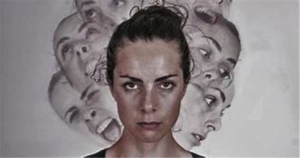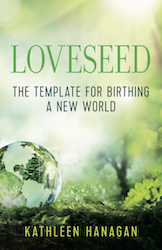This is an excerpt from my upcoming book, Loveseed: The Template For Birthing A New World.

“Someone I loved once gave me a box full of darkness. It took me years to understand that this too, was a gift.” Mary Oliver
The ability to detach from an issue or a disempowered way of seeing something is a skill everyone needs to have. The Buddha declared that all suffering comes from our attachment to things having to be other than they are. When we detach via transcendence, we move closer to our Divine nature. When we dissociate, we remain in a prison of misperception.
The truth is that everyone dissociates far more than they imagine. There are parts of us split off from other parts, and in many cases, all cut off from the loveseed.We all get our hearts broken early in life, either in the family, church, school, or with other children. We are not seen, heard, or understood by someone we have looked to for a mirror, and often someone else’s fear or hurt was projected onto us.
We were not deeply cherished as manifestations of the Divine, but often used to fill the unmet emotional and sexual needs of our parents and others. The moment of the perceived separation is so painful and/or terrifying that the human organism immediately dissociates from the felt experience, whether the pain is physical, psychological, or spiritual. To survive we naturally split off from the pain and identified with the parts that got us what we wanted and kept us safe.
Few human beings are entirely immune to the powerful influence of family and culture. Everyone adapts. I remember the day my son Jonathan dropped my hand when he saw his friends walking toward us. He was about seven and had already internalized the message that “big boys” don’t hold their mother’s hand.
As we adapted, we brilliantly began to develop a shell around our loveseed. Jung called this the persona, often called a “false self” or what Pia Mellody refers to as the “adapted self” in her book Facing Codependence. Most of us creatively adapted to an environment where it was clearly not safe to be fully who we were and we protected a place deep inside from getting hurt again. Our mantra became “no more broken heart.” Because we couldn’t selectively numb, we numbed the heart.
I once heard dissociation described as “poor man’s detachment.” It is an unhealthy and yet well-intentioned attempt to return to the natural state of detachment that is intrinsic to our being. We turn away or dissociate because it is instinctual. The part of your brain that perceives separation perceives death, since you cannot survive alone. This is the dilemma of being a multi-dimensional being in a body where we have limbic systems that attune us both to connection and to danger.
It has been found that many people who have endured tremendous trauma are highly attuned to the invisible world, as part of their dissociation is to detach to a place of comfort and light. They are often very sensitive, intuitive, and gifted in countless ways. After the battles with my father, I would hide in the closet and drift off in exhaustion and shame to a place of light, as I imagined my beautiful and strong guardian angel holding me. I became attuned to this world of invisible help and guidance.
Though we must not underestimate the power of our own woundings, we must not dwell there. We revisit consciously to heal and pluck the wisdom from the garden of experience and give our gift. The gift we have to offer the world often emerges from the wound. ![]()
The neglected child becomes self-reliant and someone others can count on. The child whom a parent leans on and confides in becomes a very attuned therapist. A child who is abused physically grows up to run a shelter for abused animals, and on it goes. The Sufi master Pir Vilayat Inayat Khan says, “The same pain that can blemish our personality can act as a creative force, burnishing it into an object of delight.”
We have not yet spoken of the outrageous and inhuman abuse that continues today. Some of you who are reading this now have been brutally abused, raped, criticized, rejected, humiliated, and disowned. I have been transformed by what I have come to know about the suffering of humanity. I, too, was hurt by a father who was disconnected from hisloveseedsome of the time and genuinely loving at others. It is confusing for children to have a parent who is safe and loving sometimes and not at others. It makes you very vigilant and untrusting, and yet over and over again you will be tempted to put yourself in harm’s way, because that is the template that was created.
I recall studying attachment theory while earning my Masters degree in Social Work. There was a photo of a policewoman holding an 18-month-old girl in her arms, walking away from a woman with a cigarette her mouth. The baby was reaching over the policewoman’s shoulder with both arms, screaming for her mother. The child had cigarette burns all over her arms and legs. That image is seared into my memory.
We know a great deal about trauma and PTSD now, thanks to studies with veterans. We know that neural pathways are formed during traumatic moments that can be easily fired later, if something similar occurs. Vets often have a hard time on the Fourth of July. Sound or scent from deep in the auditory or olfactory memory banks can trigger a massive panic attack. Yet that is true for all of us. We learned to dissociate far more than we know. You dissociate every time you go into a theatre, and often throughout the day, when you drift off, paying attention to the voices in your head, with full-fledged board meetings and family feuds, rather than be present with what is going on in your immediate environment.
Trauma induces very intense dissociation that can break through suddenly, causing a person to keep the original feeling alive. In the moment of being triggered, it is a huge challenge for a traumatized person to remain present in the moment. As trauma expert Kate Hudgins says in her book Healing World Trauma With the Therapeutic Spiral, “Introspection, the ability to look at one’s self, the ability to take an objective stance, is impaired in trauma. There are too many unconscious pathological narratives.“
Each of us copes with trauma and emotional wounding in a unique way. What is devastating for one is not so for another. It is not so much the wounding that continues to hold us back, but the meaning we attribute to it that shapes our lives. Known for her books on parental child abuse including The Drama of the Gifted Child, Swiss psychologist Alice Miller says, “It is not the trauma itself that is the source of illness but the unconscious, repressed, hopeless despair over not being allowed to give expression to what one has suffered and the fact that one is not allowed to show and is unable to experience feelings of rage, anger, humiliation, despair, helplessness, and sadness.”
We live in a dissociative culture right now. Most everyone I know shows symptoms of ADD, anxiety is rampant as never before, and younger than ever. The pace is simply too fast to remain fully present to what is going on in the moment, and most moments are spent attached to digital devices.
Connection, joy, and healing all happen when we are fully present. Being fully present to anger can transform into a moment of power. Being fully present to internal fear can transform into a moment of courage, and being fully present to sadness can transform into moments of deep love. ![]()
May I always see the opportunity in all the challenges of my life.
May I have the courage to fully feel what is within me.
May I have the wisdom to choose the highest expression of my soul.


